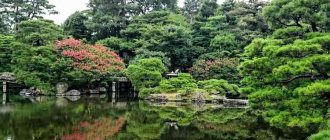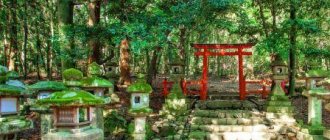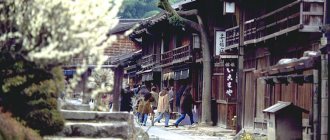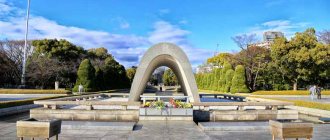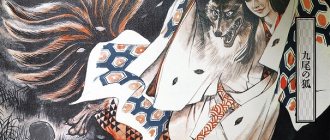The Fushimi Inari Temple complex is the main shrine of the Shinto cult of the deity Inari, the patron of cereals, abundance and success in life. The colorful temple complex lies at the foot of Mount Inari, and along the road you can see many smaller shrines.
Inari Shrines are the most famous Japanese shrines. Fushimi Inari Taisha is the main temple with which all the others are connected. For more than 1,000 years since its founding in 711, people have gathered here to pray for bountiful harvests, business prosperity, the safety of their home and family, and the fulfillment of all kinds of other desires. The temple becomes a place of pilgrimage for millions of believers on the Japanese New Year - O-shogatsu.
In recent years, the temple's Japanese worshipers have been joined by foreign visitors who come to pray for their needs or simply visit the shrine. Fushimi Inari is now known throughout the world as one of the most iconic landmarks in Kyoto and Japan as a whole.
© Maxim Starostin
Fushimi Inari Shrine opening hours
The Fushimi Inari Shrine complex is open 24/7 daily. Entrance to the complex is free for all visitors, but there are several rules, since the complex is a shrine where the deity Inari Okami resides, as well as a place of worship.
To show due respect and education to this sacred area and to ensure the safety of all visitors, when visiting Fushimi Inari the following is prohibited:
- enter areas closed to the public (the main building of the temple and other buildings, as well as fenced areas);
- shouting, sitting in sanctuary seats, and other actions that may disturb the congregation;
- eat or drink while walking;
- litter (including plastic bottles or cans);
- smoking or using any type of fire;
- flying drones, radio-controlled aircraft;
- walking through shrines in wedding dresses, cosplay or other unusual clothes;
- using a tripod for photography on narrow paths;
- photography or video shooting in places where it is prohibited;
- commercial activities and photography and filming for commercial purposes on the temple premises;
- engaging in activities such as journalism or polling without permission;
- parking for purposes other than visiting the temple;
- approach wild animals;
- any other actions that Fushimi Inari considers inappropriate.
Any visitor who violates the above rules will be required to leave the temple complex.
Tickets and tours to Fushimi Inari Shrine Complex Buy at
Buy a ticket to the Fushimi Inari Shrine Complex Buy at
© Maxim Starostin
Story
The first religious buildings on Inariyama Hill were created on the first day of the second month of 711. It is believed that then Inari Okami, the deity of Fushimi Inari Taisha, settled in Mitsugamine, Inariyama, Kii-gun, Yamashiro Province. In 816, the buildings were moved on the orders of the monk Kukai. In 908, the temple was renovated by Fujiwara Tokihira. In 927, the Fushimi Inari complex was included in the list of the highest ranking shrines throughout Japan, and in 942 it was elevated to the highest rank of Shinto shrines. In 1468, the temple buildings both on the mountain and below were destroyed by fire during the attack of Yamana Mochitoyo and his accomplices on Honekawa Doken.
The main part of the complex, together with the temple buildings, was rebuilt in 1499. The main gate was built in 1589, and the buildings of the complex were restored again in 1694. In 1871, the complex was designated as Kanpei Taisha (a great shrine under the supervision of the Department of Worship) by the new Meiji government. With the passage of the National Treasure Preservation Act in 1909, the main temple building became a national treasure and an important cultural property. In 1946, Fushimi Inari registered as a religious organization. In 2011, the temple complex celebrated the 1300th anniversary of the founding of the temple.
Complex
The entirety of Inariyama, the 233-meter-tall sacred mountain on which Fushimi Inari Taisha rests, is considered a shrine site. Lesser shrines (hokora), former shrine sites where deities remain (shinseki), cult stones engraved with the names of deities (otsuka), temple gates (torii) and other elements can be found throughout this holy area. Inariyama is one of the southernmost of the 36 mountains of Higashiyama.
The most recognizable landmarks of the Fushimi Inari complex are the main gate (楼門, ramon, "tower gate") at the bottom of the hill, the central shrine (御本殿, go-honden), and the inner shrine (奥宮, okumiya), which can be accessed get through the corridor of the “thousand gates” - bright red and black ritual torii. Also throughout the complex you can find statues of foxes - messengers of the deity Inari, one of whose attributes is a key (for a rice barn) in their mouth.
© Lyubov Razumkova
Senbon Torii
The main attraction of the Fushimi Inari Shrine is the rows of torii gates known as Senbon Torii. The custom of donating torii began to spread during the Edo Dynasty (1603–1868). In those years, gates were brought as a gift to receive the fulfillment of a cherished desire or to thank for a desire that had already become a reality. There are approximately 1,000 torii gates along the main trail.
Main temple
The temple's main building, recognized as an important cultural property, consists of five shrines: the lower, middle, upper and sub-shrines Tanaka and Shino-Okami. These five pillars of Fushimi Inari are named after the great virtues of Inari Okami that they embody:
- Ukanomitama, no Okami - Lower Shrine (central place);
- Satahiko no Okami - Middle Shrine (northern location);
- Omiyanome no Okami - Upper Shrine (southern location);
- Tanaka no Okami Tanaka Shrine is a sub-shrine of the lower shrine (northernmost location);
- Shino Okami is a sub-shrine of the middle shrine (the southernmost location).
Map of the Fushimi Inari complex on the official website
© Lyubov Razumkova
Fushimi Inari Shrine
Large scarlet torii greet you as you enter the grounds of the Fushimi Inari Shrine in Kyoto.
There are two pairs:
Goddess Inari is one of the most revered Shinto deities by the Japanese. A third of all Shinto shrines in Japan are dedicated to Inari - about 30,000 shrines!
The goddess's messengers are kitsune foxes holding Inari symbols in their teeth: a sheaf of rice, a precious stone.
Behind the gate is the complex of main buildings of the Fushimi Inari Shrine. The main gate of the temple, romon (“tower gate”). Behind them is the main building of the Fushimi Inari Shrine, the shrine:
As at any Shinto shrine, at the Fushimi Inari Shrine in Kyoto you can pray and ask the goddess for what you want. In Fushimi Inari there are paper omikuji fortune telling, and tablets in the shape of fox faces, and tiny torii gates on which wishes and requests are written.
All this is located at the base of Mount Inariyama.
The main treasure of the Fushimi Inari Shrine in Kyoto is what millions of tourists come here for every year - Senbon Torii, or thousands of torii.
How thousands of torii appeared in Fushimi Inari
The scarlet torii gates, numbering in the tens of thousands, were given to the temple as offerings by wealthy individuals and large corporations. The donor's name and date are written on the back of the gate. The black hieroglyphs on the back of the torii are just names and numbers.
The practice of giving gates in gratitude to Inari for fulfilling a request appeared in the Edo period. The oldest buildings in the Fushimi Inari Shrine complex date back to 711, even before the emergence of Kyoto as a city. The main sanctuary and buildings were erected in 1499. Soon after, orange torii corridors also appeared on Mount Inariyama. ⛩
If money is available, the giant torii gate at Fushimi Inari can still be erected today. We found out how much it would cost to purchase and install a large torii gate at the Fushimi Inari Shrine
